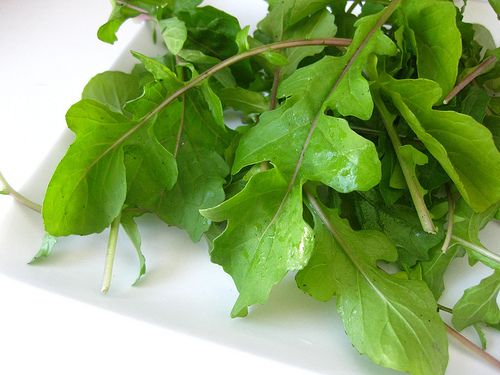
My neighbor emailed me yesterday: “Mary, do you want a bunch of arugula?” Seems she had tried it in a salad and discovered that it is one bitter vegetable.
I could be called the dumping ground for all foods confounding, and strong-tasting bitter foods are definitely in that category. So it wasn’t surprising that my neighbor asked if I could take the remaining bunch off her hands.
I accepted, albeit a little reluctantly. Although it is a “highly nutritious food,” not to mention a very trendy one, arugula’s bitter taste would take some finessing to make it palatable. In case you end up with produce on the bitter side, whether by “gift,” accident, or maybe in a CSA box, here are five tricks for taming rather than pitching it.
- Pay Attention to Seasons Arugula is a cool weather crop, which means that it grows–and tastes–best in the cooler temperatures or spring and fall.
- Pay Attention to Maturity Just as with people, vegetables get rougher and more opinionated as they age. So for vegetables that are prone to harshness, buy the baby varieties. While I generally can’t stomach fresh arugula, I was surprised at the mildness of baby arugula used in a spring salad.
- Balance (a/k/a Dilute) the Flavor Eating a whole serving of bitter food is sure to provoke a gag response. But that’s not the point. Bitter foods are meant to be used in small amounts to counterbalance too much sweetness, heat, saltiness, etc. In this way, they add wonderful dimension and depth of flavor to a dish. In our New Kitchen classes, we teach about the six main flavors, including bitter, and how to balance them for intriguing flavor.
- Fresher Is Better This is true for any vegetable, since flavor and nutrients are at their peak when a vegetable is picked at its prime. For bitter vegetables in particular, allowing them to sit in the frig, gradually losing their moisture content and freshness might well concentrate their bitter flavor.
- Cook Them “Cooking tames” is a fundamental principle we share in our New Kitchen classes, where we learn about strong and bitter vegetables like turnips, radishes and arugula. Too much cooking, of course, and the food turns bland and mushy–kind of like the way a lot of us remember the vegetables our mothers’ made! But gentle, careful cooking can take down the high notes and blend everything together into a pleasing melody.

Putting these principles to work, I went to work taming my neighbor’s arugula. I started by sauteing an onion for a sweeter base. Red Anaheim peppers brought lovely color and mild heat. Then I went two directions:
- For my breakfast, I scrambled the arugula mixture with a couple eggs, which are also on the sweeter end of the spectrum.
- For my neighbor, I added a pear for serious sweetness. Salt and a splash of red wine vinegar made for a fairly complete flavor combination.
The Verdict: The arugula was still bitter, my neighbor reported, but the pears definitely made it good enough to eat–and she’s right. A bitter vegetable will always be bitter, the best we can do is tone it down and balance it with other flavors for a dish that’s passable and even a little enjoyable–and so we avoid tossing it in the trash.

Caption:
5 thoughts on “Waste Not, Want Not: 5 Tricks for Cooking Not Tossing Bitter Foods”